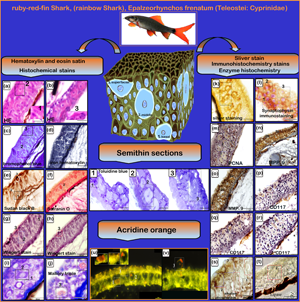Crossref Citations
This article has been cited by the following publications. This list is generated based on data provided by
Crossref.
Salah, Abdallah S.
El-Nagar, Sahar H.
Elsheshtawy, Ahmed
Al-Dhuayan, Ibtesam
Fouad, Alamira Marzouk
Alnamshan, Mashael M.
Kadira, Hossam I.
Alaqeel, Nouf K.
El-Shobokshy, Set A.
Shukry, Mustafa
and
Abd-Elhafeez, Hanan H.
2022.
Exploring the multimodal role of Cnicus benedictus extract in the modulation of growth, hematobiochemical, histopathological, antioxidative performance, and immune-related gene expression of Oreochromis niloticus challenged with Aeromonas hydrophila.
Frontiers in Marine Science,
Vol. 9,
Issue. ,
Mohamed, Yara
El Ghareeb, Abdel-Wahab
Attaby, Fawzy Ali
and
Abd El-Rahman, Heba Ali
2022.
Estimation of silver nanoparticles effect on the reproductive health of female Wistar rats.
Egyptian Journal of Basic and Applied Sciences,
Vol. 9,
Issue. 1,
p.
340.
Soliman, Soha A.
Emeish, Walaa F. A.
and
Abdel‐Hafeez, Hanan Hassan
2022.
Lactoferrin improves the immune response and resistance of silver carp, a hematological, light (histochemical and immunohistochemical), fluorescent, and scanning electron microscopic study.
Microscopy Research and Technique,
Vol. 85,
Issue. 11,
p.
3565.
Mustafa, Fatma El‐Zahraa A.
Abdelhafez, Enas A.
and
Abd‐Elhafeez, Hanan H.
2022.
Characterization of the primo vascular system in rabbit vagina.
Microscopy Research and Technique,
Vol. 85,
Issue. 2,
p.
799.
Sayed, M. A. M.
Abd-Elhafeez, Hanan H.
Afifi, O. S.
Marzouk, M. W.
and
El-Sherry, Taymour M.
2022.
Sperm tendency to agglutinate in motile bundles in relation to sperm competition and fertility duration in chickens.
Scientific Reports,
Vol. 12,
Issue. 1,
Abdo, Walied
Haziri, Imer
Dmerdash, Mohamed
Alnasser, Sulaiman Mohammed
Hakamy, Ali
Ali, Ehab
Soliman, Soha A.
Abd-Elhafeez, Hanan H.
and
Abd-Eldayem, Ahmed M.
2022.
Anatabine attenuates ovalbumin-induced asthma via oxidative stress and inflammation mitigation and Nrf2/HO-1 signaling upregulation in rats.
Life Sciences,
Vol. 308,
Issue. ,
p.
120954.
Abd-Eldayem, Ahmed M.
Alnasser, Sulaiman Mohammed
Abd-Elhafeez, Hanan H.
Soliman, Soha A.
and
Abdel-Emam, Rania A.
2022.
Therapeutic Versus Preventative Use of Ginkgo biloba Extract (EGb 761) against Indomethacin-Induced Gastric Ulcer in Mice.
Molecules,
Vol. 27,
Issue. 17,
p.
5598.
Magdy, Menna-Tullah
EL-Ghareeb, Abd EL-Wahab A
Attaby, Fawzy A
and
Abd El-Rahman, Heba A
2022.
Assessment of nano-iron particles impact on the reproductive health of female Wistar rats.
Beni-Suef University Journal of Basic and Applied Sciences,
Vol. 11,
Issue. 1,
Soliman, Soha A
Abd-Elhafeez, Hanan H
Abou-Elhamd, Alaa S
Kamel, Basma Mohamed
Abdellah, Nada
and
Mustafa, Fatma El-Zahraa A
2023.
Role of Uterine Telocytes During Pregnancy.
Microscopy and Microanalysis,
Vol. 29,
Issue. 1,
p.
283.
Alnasser, Sulaiman Mohammed
Alotaibi, Meshal
Ramadan, Nancy K
Abd ElHafeez, Hanan H
and
Abdel-Hakeem, Sara Salah
2023.
The Efficiency ofSchistosoma mansoniCrude Antigens in Inhibition of Heat Shock Protein, Apoptosis, and Lysosomal Activity: An Immunohistochemical Study.
Microscopy and Microanalysis,
Vol. 29,
Issue. 2,
p.
739.
Alblihd, Mohamed A.
Alsharif, Khalaf F.
Hamad, Asmaa A.
Ali, Fatma Abo Zakaib
Hussein, Manal T.
Alhegaili, Alaa S.
Hassan, Mohamed Ahmed
Al-Amer, Osama M.
Albezrah, Nisreen Khalid Aref
Almalki, Abdulraheem Ali
Albarakati, Alaa Jameel A.
Alghamdi, Khalid S.
Alzahrani, Khalid J.
Albrakati, Ashraf
Alrubai, Elham Hamed
ElAshmouny, Naira
and
Elmahallawy, Ehab Kotb
2023.
Okra [Abelmoschus esculentus (L.) Moench] improved blood glucose and restored histopathological alterations in splenic tissues in a rat model with streptozotocin-induced type 1 diabetes through CD8+ T cells and NF-kβ expression.
Frontiers in Veterinary Science,
Vol. 10,
Issue. ,
Abdel-Hakeem, Sara Salah
Abdel-Samiee, Mahmoud Abdel-Zaher
Youssef, Mohamed Salah Eldin
Abd-Elsadek, Shimaa Hamdi
Abd-Elrahman, Salwa Mahmoud
and
Abdel-Hakeem, Sally Salah
2024.
Nanocurcumin: A Promising Therapeutic Candidate for Experimental Trichinellosis.
Microscopy and Microanalysis,
Vol. 30,
Issue. 2,
p.
368.






